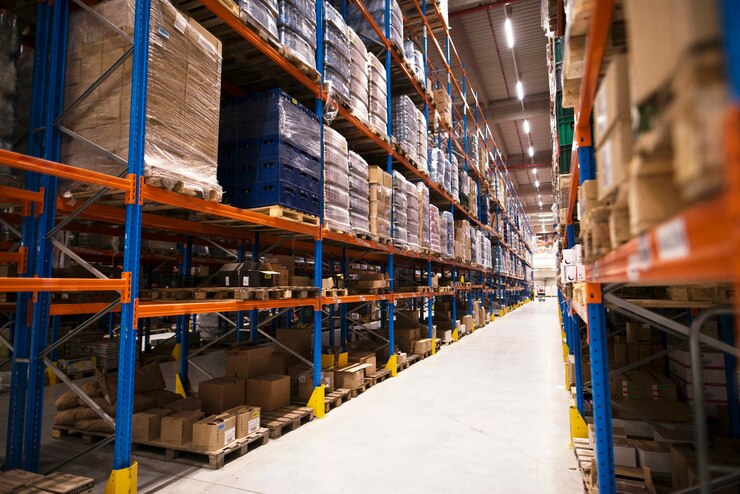Marketplace Warehousing Solution Overview
Karbon Digital Offers comprehensive marketplace warehousing solutions designed to streamline logistics and enhance the efficiency of e-commerce operations. Our solutions provide a robust infrastructure that caters to the diverse needs of online retailers, ensuring seamless inventory management, order fulfillment, and distribution. By leveraging advanced technologies and industry best practices, we help businesses optimize their supply chain, reduce operational costs, and improve customer satisfaction.

Advantages of Marketplace Warehousing
Marketplace warehousing by Karbon Digital Limited offers significant advantages that streamline logistics, enhance operational efficiency, and drive customer satisfaction. By integrating advanced technologies and best practices, our solutions ensure seamless inventory management, fast and accurate order fulfillment, and scalable storage options. These advantages enable businesses to optimize their supply chain, reduce costs, and maintain a competitive edge in the e-commerce landscape.
- Efficient Inventory Management
- Seamless Order Fulfillment
- Scalable Storage Solutions
- Advanced Technology Integration
- Robust Security Measures
- Customizable Solutions
- Efficient Returns Management

Our marketplace warehousing solutions are
designed to enhance the efficiency and scalability of your e-commerce operations. By leveraging advanced technologies and industry best practices, we provide robust and secure warehousing infrastructure that supports seamless inventory management, order fulfillment, and distribution.
AI Use Cases in Marketplaces and Warehousing
Marketplaces
Personalized Product Recommendations
- Use Case: AI-driven recommendation engines analyze user behavior, preferences, and purchase history to suggest relevant products.
- Benefits: Enhances user engagement, boosts conversion rates, and increases sales.
Dynamic Pricing Models
- Use Case: AI models optimize pricing in real-time based on demand, competitor pricing, and inventory levels.
- Benefits: Maximizes revenue while maintaining competitiveness.
Customer Sentiment Analysis
- Use Case: AI-powered tools analyze reviews, ratings, and social media comments to gauge customer sentiment and feedback on products and services.
- Benefits: Improves customer experience and informs product enhancements.
Fraud Detection & Prevention
- Use Case: AI algorithms monitor transactions and seller activities to detect fraudulent behavior, fake reviews, or counterfeit products.
- Benefits: Enhances platform trust and security.
Product Categorization & Search Optimization
- Use Case: AI automates the categorization of products and improves search results by understanding user intent through NLP and image recognition.
- Benefits: Increases product discoverability and reduces manual effort.
Smart Customer Support
- Use Case: AI chatbots and virtual assistants can handle common queries related to orders, returns, and product details.
- Benefits: Improves response time and reduces support costs.
Marketplace Trend Analysis
- Use Case: AI can identify emerging product trends by analyzing buying patterns and market data, helping sellers and marketplace operators stay competitive.
- Benefits: Drives growth by identifying high-demand products early.
Return Prediction & Management
- Use Case: AI models predict the likelihood of product returns based on historical data and recommend actions to reduce them, such as better descriptions or images.
- Benefits: Lowers return rates and associated costs.
Warehousing
Inventory Forecasting & Optimization
- Use Case: AI models predict demand patterns and optimize stock levels by considering sales trends, seasonality, and external factors like market events.
- Benefits: Minimizes overstocking and stockouts, reducing holding costs.
Automated Quality Control
- Use Case: AI-powered image recognition systems inspect products for defects during the warehousing process.
- Benefits: Ensures product quality and reduces customer complaints.
Smart Warehouse Robotics
- Use Case: AI-driven robots can handle tasks such as picking, packing, and sorting items, improving speed and accuracy.
- Benefits: Enhances operational efficiency and reduces labor costs.
Warehouse Layout Optimization
- Use Case: AI can recommend optimal warehouse layouts by analyzing product movement patterns to minimize picking time and maximize space utilization.
- Benefits: Increases throughput and operational efficiency.
Automated Order Fulfillment
- Use Case: AI can coordinate the end-to-end fulfillment process, including picking, packing, and shipping orders.
- Benefits: Improves order accuracy and reduces fulfillment time.
Energy Consumption Optimization
- Use Case: AI can monitor and optimize energy usage in warehouses by controlling lighting, HVAC systems, and machinery based on real-time demand.
- Benefits: Reduces operational costs and supports sustainability goals.
Predictive Maintenance for Warehouse Equipment
- Use Case: AI monitors equipment such as conveyor belts and forklifts to predict maintenance needs before failures occur.
- Benefits: Reduces downtime and extends equipment lifespan.
Real-Time Shipment Tracking
- Use Case: AI can provide real-time insights on shipment status and predict delays by analyzing traffic, weather, and logistical data.
- Benefits: Enhances customer satisfaction and improves supply chain visibility.
Automated Replenishment
- Use Case: AI systems can trigger automatic replenishment orders when inventory levels fall below a set threshold.
- Benefits: Ensures product availability and reduces manual intervention.
Workforce Optimization
- Use Case: AI can analyze work patterns to optimize staff schedules, ensuring the right number of employees are available at peak times.
- Benefits: Improves productivity and reduces labor costs.



